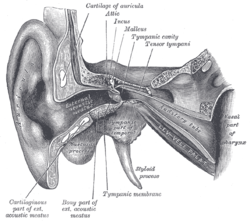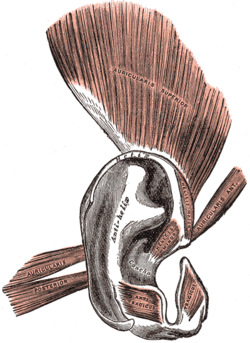Outer ear
| Outer ear | |
|---|---|

External and middle ear, opened from the front. Right side.
|
|

The auricula. Lateral surface.
|
|
| Details | |
| Identifiers | |
| Latin | auris externa |
| MeSH | A09.246.272 |
| Dorlands /Elsevier |
Outer ear |
| TA | A15.3.01.001 |
| FMA | 52781 |
|
Anatomical terminology
[]
|
|
| Intrinsic muscles of external ear | |
|---|---|

The muscles of the auricula
|
|
| Details | |
| Nerve | Facial nerve |
| Actions | Undeveloped in humans |
| Identifiers | |
| TA | A15.3.01.001 |
| FMA | 52781 |
|
Anatomical terms of muscle
[]
|
|
| Auricular muscles | |
|---|---|

The muscles of the pinna
|
|

Auricular muscles in context with the other facial muscles
|
|
| Details | |
| Origin | Galeal aponeurosis |
| Insertion | Front of the helix, cranial surface of the pinna |
| Artery | Posterior auricular artery |
| Nerve | Facial nerve |
| Actions | Undeveloped in humans (wiggle ears) |
| Identifiers | |
| Latin | Musculi auriculares |
| TA | A15.3.01.001 |
| FMA | 52781 |
|
Anatomical terms of muscle
[]
|
|
The outer ear is the external portion of the ear, which consists of the auricle (also pinna) and the ear canal. It gathers sound energy and focuses it on the eardrum (tympanic membrane).
The visible part is called the auricle, also known as the pinna, especially in other animals. It is composed of a thin plate of yellow elastic cartilage, covered with integument, and connected to the surrounding parts by ligaments and muscles; and to the commencement of the ear canal by fibrous tissue. Many mammals can move the pinna (with the auriculares muscles) in order to focus their hearing in a certain direction in much the same way that they can turn their eyes. Most humans do not have this ability.
From the pinna the sound waves move into the ear canal (also known as the external acoustic meatus) a simple tube running through to the middle ear. This tube leads inward from the bottom of the auricula and conducts the vibrations to the tympanic cavity and amplifies frequencies in the range 3 kHz to 12 kHz.
The intrinsic muscles of the external ear are the:
The auricular muscles (or extrinsic muscles) are the three muscles surrounding the auricula or outer ear:
The superior muscles is the largest of the three, followed by the posterior and the anterior.
In some mammals these muscles can adjust the direction of the pinna. In humans these muscles possess very little action. The auricularis anterior draws the auricula forward and upward; the Auricularis superior slightly raises it; and the Auricularis posterior draws it backward.
One consequence of the configuration of the outer ear is selectively to boost the sound pressure 30- to 100-fold for frequencies around 3 kHz. This amplification makes humans most sensitive to frequencies in this range — and also explains why they are particularly prone to acoustical injury and hearing loss near this frequency. Most human speech sounds are also distributed in the bandwidth around 3 kHz.
...
Wikipedia
